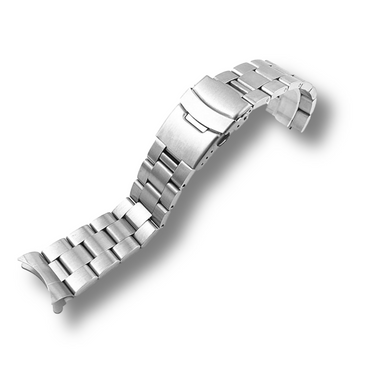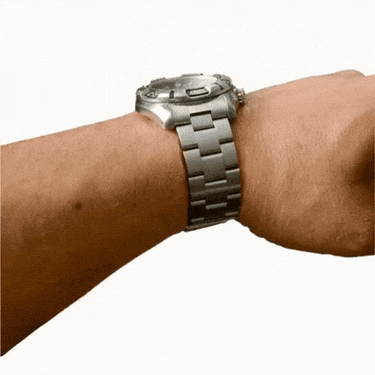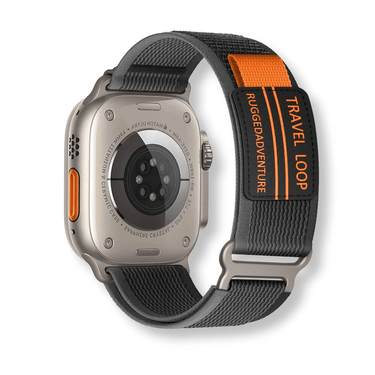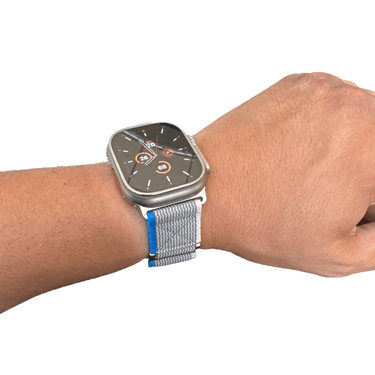The world of timepieces is a fascinating realm that combines functionality, craftsmanship, and style. Among the many components that make up a watch, the watch band holds a significant place.
Not only does it secure the timepiece to our wrists, but it also contributes to the overall aesthetic appeal and comfort of wearing a watch. The choice of a suitable watch band can transform an ordinary timepiece into an extraordinary accessory that reflects our personality and enhances our attire.
In recent years, there has been a noticeable trend towards larger watch sizes in the horological industry. Gone are the days when smaller watches dominated wrists; nowadays, bigger is often deemed better.
Larger case sizes have gained popularity among both men and women as they make a bold fashion statement while providing increased legibility of dial details. However, this shift towards larger watches has raised an intriguing question: Can a 42mm watch band fit a 44mm watch?
While this may seem like a minor concern to some, it is essential to understand the compatibility between case size and band width to ensure optimal functionality and visual harmony. For those unfamiliar with watch anatomy, it's important to clarify that when we refer to "42mm" or "44mm," we are referring primarily to the diameter of the watch case itself.
The size of the case influences not only its visual impact but also determines other aspects such as movement choice or dial design possibilities. The aim of this article is to delve into this matter with great detail, exploring relevant factors such as industry practices for matching band widths with case sizes, potential issues related to fitting smaller bands on larger watches, expert opinions on this topic, and practical recommendations for finding compatible bands for different-sized timepieces.
Understanding Watch Sizes and Bands
Differentiating between watch case size and band width
When discussing watches, it is important to differentiate between the watch case size and the band width. The watch case size refers to the diameter of the watch face itself and is usually measured in millimeters.
This measurement determines how large or small the watch will appear on your wrist. On the other hand, band width refers to the measurement between the lugs where the band attaches to the case.
It's worth noting that while both measurements are crucial in determining a watch's overall fit and aesthetic appeal, they serve different purposes. The case size may vary greatly depending on personal preference and trends, while band width plays a significant role in ensuring a comfortable and secure fit on your wrist.
Watch case size refers to the diameter of the watch face
The watch case size is arguably one of the most noticeable aspects when it comes to choosing a timepiece. It directly impacts how prominent or subtle it appears on your wrist, as well as its overall style statement.
Consequently, individuals with smaller wrists often opt for more modestly sized cases, such as those around 38mm or 40mm, aiming for a proportional look. Conversely, those seeking a bold fashion statement might prefer larger cases ranging from 42mm up to 50mm or even beyond.
Measuring watch case sizes accurately typically involves measuring across its widest point – often from one edge of its bezel (the outer ring surrounding the dial) to another. While there are standard industry sizes available, brands may deviate slightly from these conventions in their designs.
Band width refers to the measurement between lugs where bands attach
While choosing a suitable band width might not initially seem as crucial as selecting an appropriate case size, it plays an essential role in both comfort and aesthetics. The band width refers to the measurement between the lugs, those protruding tabs on either side of the watch case where the band gets attached. It determines the strap's compatibility and how well it aligns with the overall design of your timepiece.
Band widths can range from as narrow as 14mm on delicate timepieces to wider options exceeding 26mm for bolder or sportier styles. To measure band width accurately, focus on determining the distance between the inner edges of both lugs at their widest points.
This measurement ensures that when attaching a new band, it securely fits within and seamlessly integrates with your watch case. It is worth noting that while watch case size tends to have standardized measurements within models, band width may vary across different collections and brands.
To ensure a perfect fit, it is vital to determine both your watch's case size and its corresponding recommended band width before making any purchasing decisions. Understanding the distinctions between watch case size and band width is essential when selecting a timepiece that suits your style and wrist comfortably.
The case size influences how prominent or subtle a watch appears on your wrist, while the band width determines how securely it attaches to your timepiece. By comprehending these distinctions, you can make informed choices when exploring different watches or contemplating replacing a worn-out or unsuitable strap.
Exploring Watch Band Compatibility
Standard industry practices for matching band widths with case sizes
When it comes to watch bands, one crucial aspect to consider is their compatibility with the watch case size. The standard industry practice suggests that the band width should be equal to or slightly smaller than the lug width on the watch case.
The lug width refers to the measurement between the lugs where the band attaches to the case. Maintaining a proportional relationship between the band and watch case is essential for both aesthetics and functionality.
A properly fitted band ensures a secure and comfortable fit while complementing the overall design of the timepiece. It also prevents unnecessary stress on both the band and lugs, prolonging their durability.
General rule: Band width should be equal to or slightly smaller than lug width
The general rule of thumb dictates that a watch band's width should match or be marginally narrower than the lug width on the watch case. This alignment ensures a seamless connection between the two components, guaranteeing a well-balanced appearance.
Matching band and lug widths offer various advantages. First, it prevents any gaps or misalignment between them, eliminating potential discomfort or risks of accidental detachment.
Second, it maintains consistent proportions throughout all aspects of timepiece design, enhancing its visual appeal. However, deviating from this general rule may still lead to compatibility in some cases due to factors like lug shape and design.
Factors that influence compatibility: Lug shape and design
While adhering to standard practices is vital in ensuring compatibility between watch bands and cases, certain factors can influence whether a 42mm band can comfortably fit a 44mm watch. One such factor is lug shape. Tapered lugs are narrower at their connection point with the band but gradually widen towards their ends where they attach to the case.
In this scenario, a 42mm band may fit a 44mm watch with tapered lugs more seamlessly compared to straight lugs. Straight lugs maintain a consistent width from the case connection to their ends.
Another factor is lug design. Some watches have curved lugs that follow the natural contour of the wearer's wrist.
Curved lugs can accommodate slightly wider bands due to their increased space between the band and wrist. Additionally, flat lugs, with their minimal curvature, may offer limited flexibility in terms of band compatibility.
In such cases, it is advisable to opt for narrower bands within the acceptable range to ensure a proper fit without compromising comfort or aesthetics. Considering these factors alongside industry practices will guide consumers in determining whether a 42mm band can indeed fit a 44mm watch while maintaining optimal functionality and style.
Exploring watch band compatibility involves adhering to standard industry practices by matching band widths with case sizes. The general rule suggests that the band width should be equal to or slightly smaller than the lug width on the watch case.
However, factors like lug shape and design can influence this compatibility. Tapered lugs and curved lug designs may offer more flexibility when fitting a slightly smaller band on a larger watch case.
Conversely, watches with straight or flat lugs might require narrower bands for optimal compatibility. By considering these aspects of compatibility and following expert guidelines, individuals can make informed decisions when selecting appropriate bands for their timepieces.
Case Study: Can a 42mm Band Fit a 44mm Watch?
Analyzing potential scenarios and considerations
When contemplating whether a 42mm watch band can fit a 44mm watch, it is crucial to delve into the intricacies of lug design variations between different brands and models. The compatibility between the band and the watch case greatly depends on the shape and style of the lugs.
Two primary lug designs that influence this compatibility are tapered lugs versus straight lugs, as well as curved lugs versus flat lugs. Tapered Lugs vs Straight Lugs: Tapered lugs gradually narrow down from the case to where the band attaches, providing a subtle aesthetic transition.
On the other hand, straight lugs maintain an even width from the case to where they meet with the band. When fitting a smaller band on a larger watch with tapered lugs, it might be easier to achieve a seamless connection due to their narrower endpoint.
However, with straight lugs, there may be some concerns regarding any potential gaps or misalignment when using bands of smaller widths. Curved Lugs vs Flat Lugs: Some watches feature curved lugs that follow the contour of your wrist for enhanced comfort and better integration with certain bands.
When attempting to fit a smaller band on a larger watch with curved lugs, there is often more leeway as these curved designs can accommodate various sizes without compromising aesthetics or functionality. In contrast, watches with flat lug designs may pose challenges when trying to fit smaller bands since there might be noticeable gaps or strain on both ends.
Assessing potential issues with fitting a smaller band on a larger watch
While it may be possible to match a 42mm band onto a 44mm watch depending on lug design and other factors, several issues should be considered before proceeding. One potential concern is the possibility of gaps or misalignment between the band and the lugs.
If the difference in size is significant, there might be visible spaces between the band and the watch case, affecting both aesthetics and comfort. Another factor to consider is how a smaller band would affect comfortability and aesthetics.
If the band width does not proportionally match the watch size, it could result in an imbalanced look. Additionally, wearing a narrower band on a larger watch might cause discomfort if there are sharp edges or uneven weight distribution.
It's worth noting that manufacturers typically design specific bands for their watches based on case size to ensure optimal compatibility and aesthetics. Deviating from these recommendations may compromise both functionality and style.
While it may be tempting to experiment with mixing different-sized watch bands with various models, caution should be exercised. Analyzing lug design variations such as tapered versus straight lugs and curved versus flat lugs provides insight into potential compatibility issues that could arise when attempting to fit a smaller band on a larger watch.
Furthermore, considering issues like gaps or misalignment between the band and lugs, as well as comfortability and aesthetics, allows one to make an informed decision regarding fitting a 42mm band onto a 44mm watch. Ultimately, adhering to manufacturer guidelines ensures optimal compatibility and preserves the overall integrity of your timepiece.
Expert Opinions and Recommendations
Insights from horologists, collectors, and industry experts on this matter
When it comes to the question of whether a 42mm watch band can fit a 44mm watch, there are varying opinions among experts in the field. Horologists, collectors, and industry experts have weighed in on this matter from their experiences and perspectives.
Arguments for using a smaller band on a larger watch: Some experts argue that using a smaller band on a larger watch can create an interesting contrast and give the timepiece a unique look. It might also provide an opportunity to showcase the craftsmanship of the watch case itself when paired with a slightly narrower band.
Additionally, proponents of this approach suggest that it allows for more versatility as one can interchange bands between different watches. Arguments against using a smaller band on a larger watch: On the other hand, many experts caution against using a smaller band on a larger watch due to potential aesthetic shortcomings.
They argue that it may result in unsightly gaps or misalignment between the band and the lugs, which can detract from the overall appearance of the timepiece. Moreover, wearing an ill-fitting band may compromise comfort levels and affect how securely the watch sits on your wrist.
Practical recommendations for finding compatible bands for different-sized watches
To find compatible bands for different-sized watches, consider these practical recommendations:
- Consult manufacturer guidelines: Start by checking if your specific brand provides any recommendations regarding compatible strap sizes for their watches. Manufacturers often specify ideal strap widths or provide guidance based on case size.
- Measure lug width accurately: Carefully measure your watch's lug width using calipers or an accurate ruler to determine its exact size. Knowing this measurement will help you find straps specifically designed to fit your particular model.
- Explore custom-made options: If you're looking for a precise fit or want to explore unique band options, consider custom-made straps. Many artisans specialize in crafting bespoke watch bands tailored to specific watch sizes and lug designs.
- Utilize adjustable straps: Look for adjustable straps that offer multiple size options, such as those with multiple buckle holes or quick-release mechanisms. These straps provide flexibility and can adapt to various watch case sizes.
- Seek expert advice: Don't hesitate to reach out to knowledgeable watchmakers or retailers who can offer guidance based on their expertise. They may be able to recommend compatible bands based on the specific make and model of your watch.
Conclusion
In the debate over whether a 42mm watch band can fit a 44mm watch, it becomes evident that there are differing opinions among experts in the field. While some argue for using a smaller band on a larger watch, citing aesthetic contrast and versatility as key advantages, others caution against it due to potential issues with fitment and overall appearance. Ultimately, the decision rests with the individual wearer's preferences and priorities.
It is crucial to consider both aesthetic appeal and comfort when selecting a suitable band size for your timepiece. By consulting manufacturer guidelines, measuring lug width accurately, exploring custom-made options, utilizing adjustable straps, and seeking expert advice when needed, you can increase your chances of finding compatible bands for different-sized watches.
Remember that finding the perfect band-watch combination is as much an art as it is science—a balance between personal taste and technicality. With careful consideration and attention to detail, you can enhance your timekeeping experience by ensuring that every aspect of your wristwatch harmonizes seamlessly into one timeless piece of craftsmanship
























